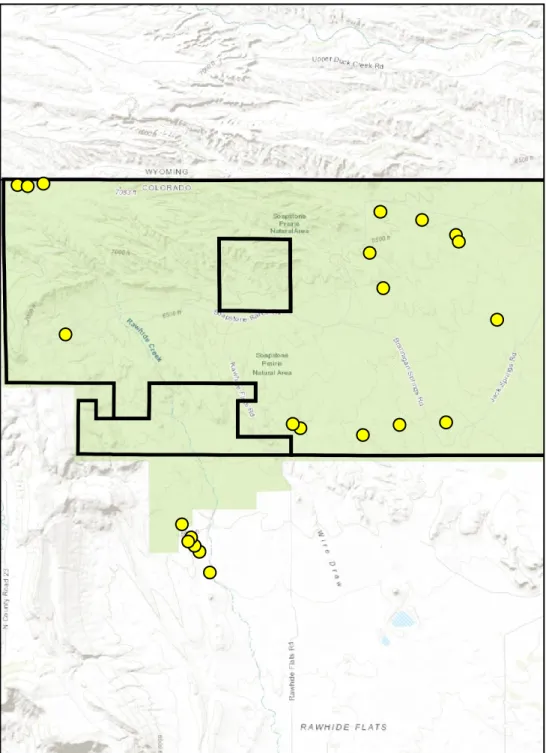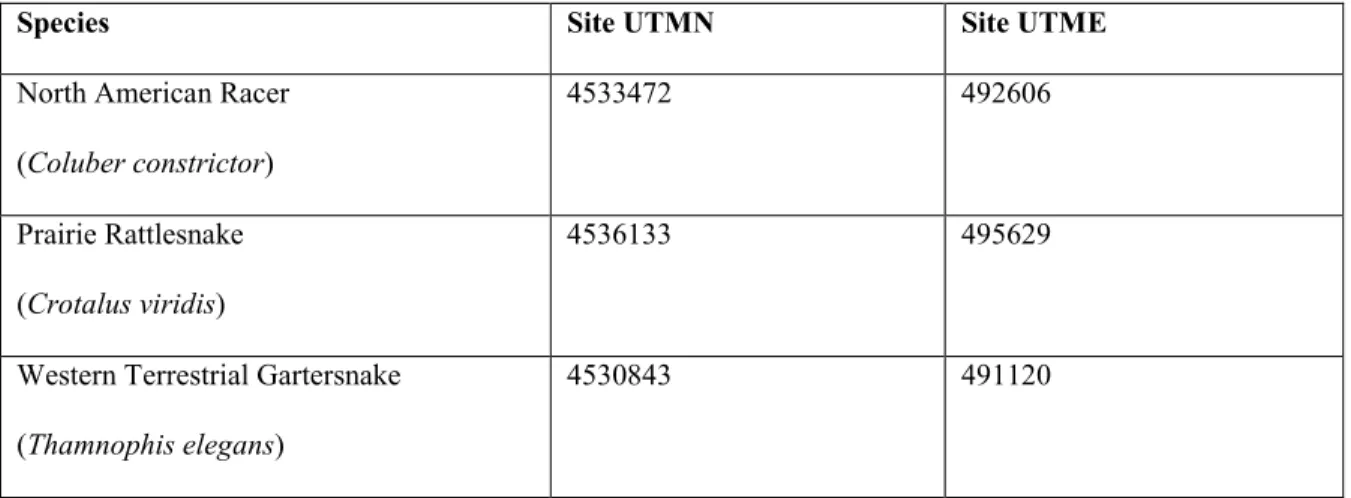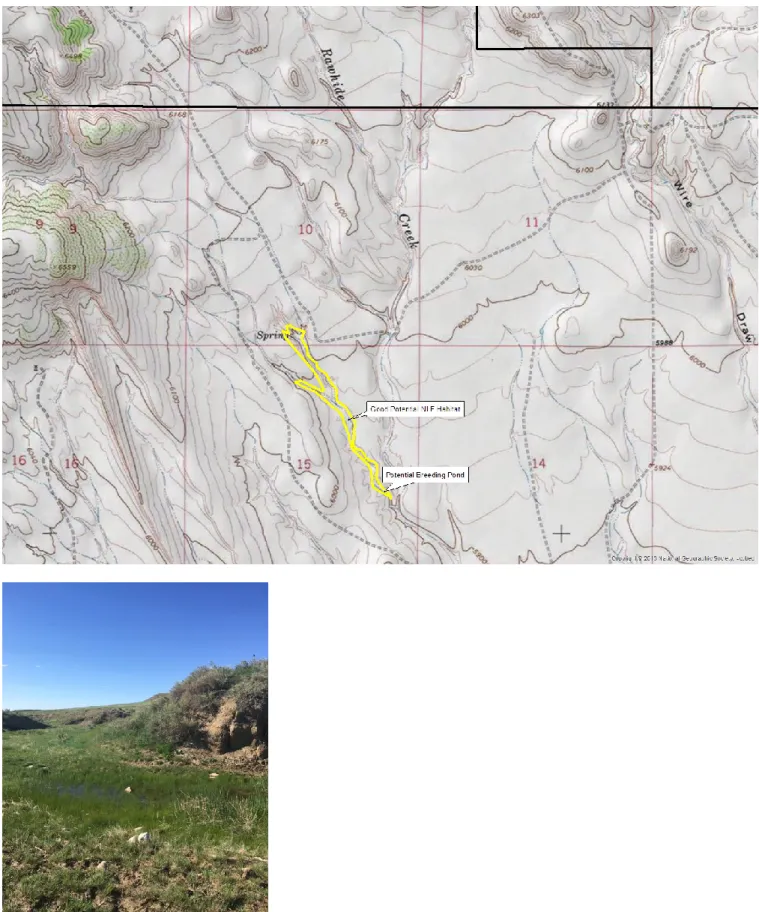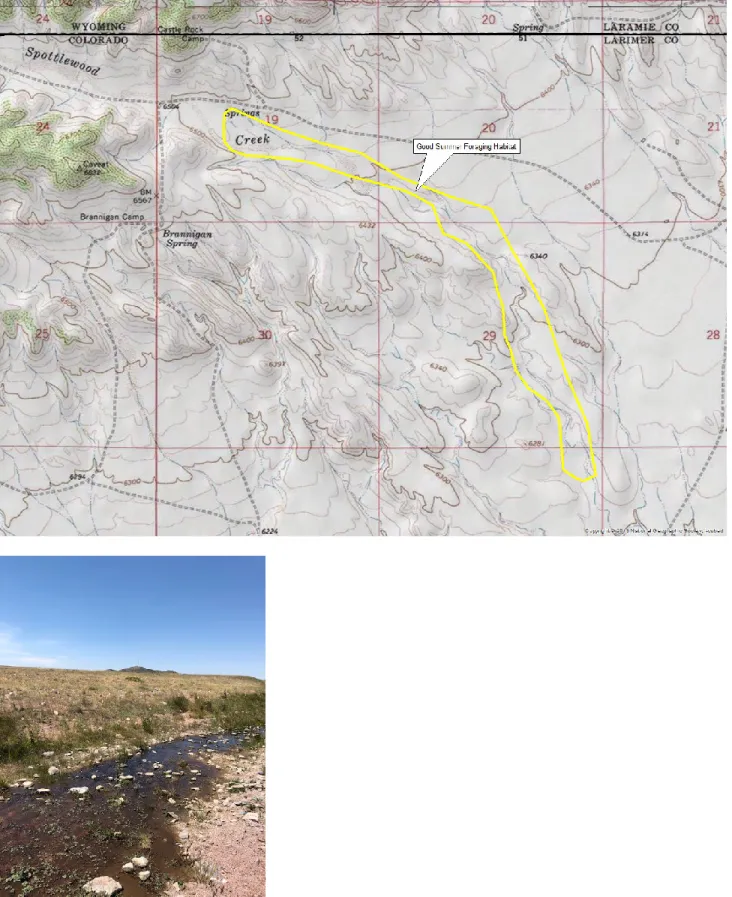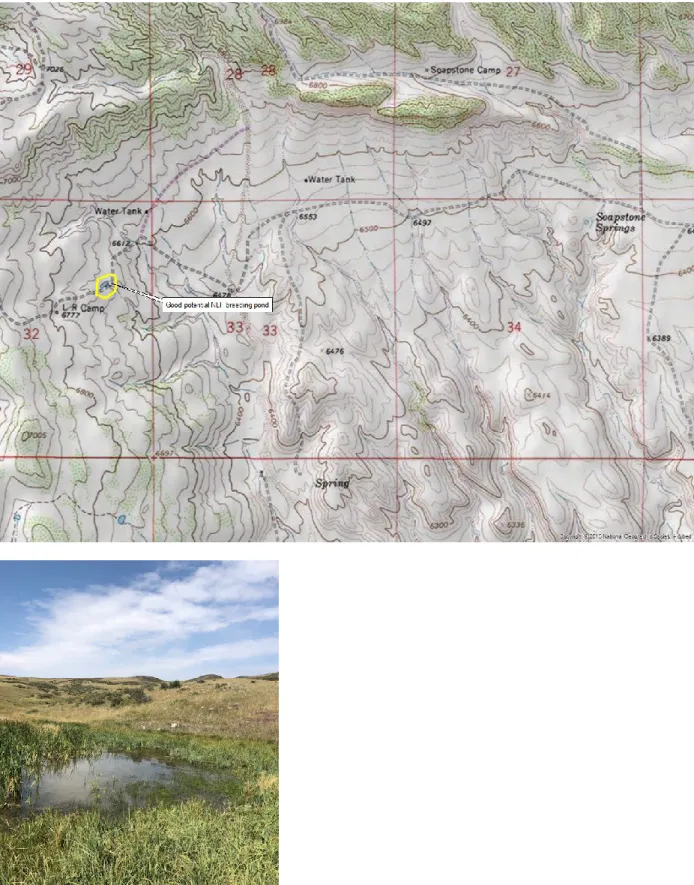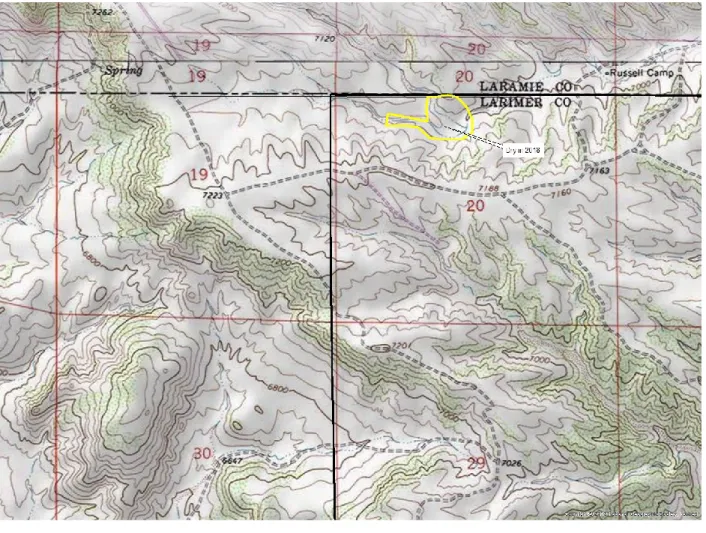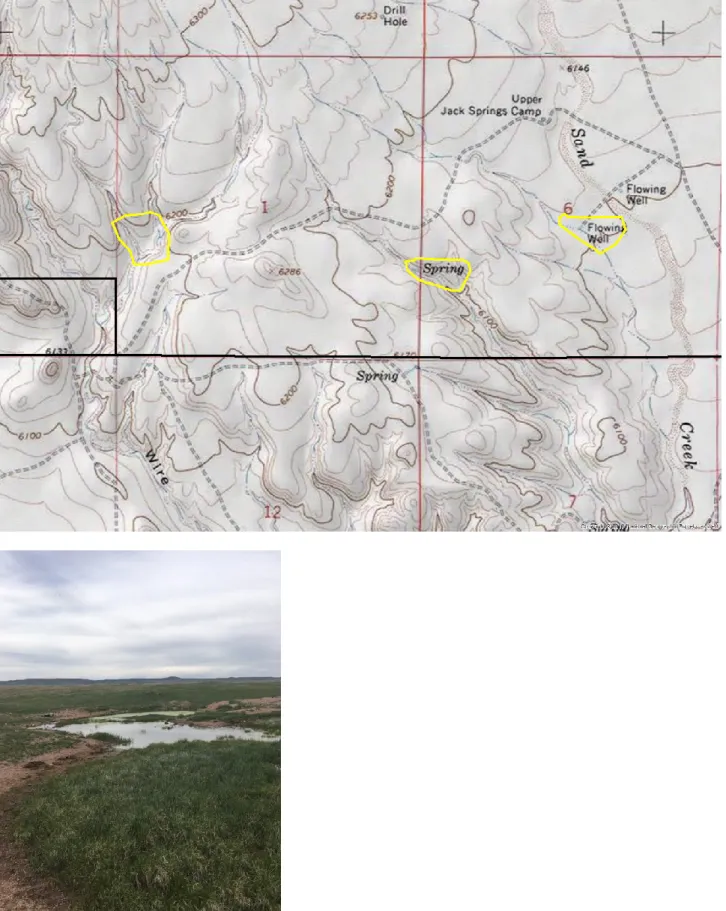October 2018
Colorado Natural Heritage Program
Amphibian Surveys on Soapstone Prairie
CNHP’s mission is to preserve the natural diversity of life by contributing the essential scientific foundation that leads to lasting conservation of Colorado's biological wealth.
Colorado Natural Heritage Program
Warner College of Natural Resources Colorado State University
1475 Campus Delivery Fort Collins, CO 80523
(970) 491-7331
Report Prepared for: Aran Meyer
City of Fort Collins Natural Areas 1745 Hoffman Mill Road
Fort Collins, CO 80522
Recommended Citation:
Lambert, B. A. 2018. Colorado Natural Heritage Program Amphibian Surveys on Soapstone Prairie Natural Area. Colorado Natural Heritage Program, Colorado State University, Fort Collins, Colorado.
Colorado Natural Heritage
Program Amphibian Surveys on
Soapstone Prairie Natural Area
Brad Lambert
Colorado Natural Heritage Program Warner College of Natural Resources
Colorado State University Fort Collins, Colorado 80523
A
BSTRACT
The Colorado Natural Heritage Program (CNHP) is Colorado’s only comprehensive source of information on the status and location of Colorado’s rarest and most threatened species and plant communities. CNHP tracks and ranks Colorado’s rare and imperiled species and habitat and provides scientific information and expertise to promote the conservation of Colorado’s biological resources. Established in 1979, the CNHP is a non-profit scientific organization in the Warner College of Natural Resources at Colorado State University.
In 2018 the City of Fort Collins Natural Areas established an agreement with CNHP to conduct
amphibian surveys on the Soapstone Prairie Natural Area located in Larimer County, Colorado. Using a survey site priority list developed by Natural Area biologists, CNHP conducted amphibian surveys at 22 sites within the Soapstone Prairie Natural Area between May 7, 2018and August 28, 2018. The primary targets of the surveys were the Northern Leopard Frog but additional amphibian species present on the property were of interest as well and occurrences noted in this report. Once common throughout most of Colorado, the Northern Leopard Frog has experienced declines in distribution and abundance throughout much its range in the state. Today it is classified as a USFS sensitive species and a State of Colorado species of special concern.
Four surveys were conducted by CNHP biologists and no Northern Leopard Frogs were detected. Boreal Chorus Frogs were found calling at numerous locations throughout the natural area and one Woodhouse’s Toad was heard calling in early May. It was a very dry spring and summer on the Soapstone Natural Area which resulted in a lack of amphibian activity and breeding habitat in 2018. Although conditions were not optimal for amphibian detection, potential habitat for Northern Leopard Frogs was identified at several locations. Continued surveys are recommended to improve the confidence of documenting the presence or absence of Northern Leopard Frogs on the Soapstone Prairie Natural Area. There is a recent observation of this species at the nearby Meadow Springs Ranch that suggests the possibility of Northern Leopard Frogs on the Soapstone Prairie Natural Area.
T
ABLE OF
C
ONTENTS
C
ONTENTS
Abstract ... 4 Table of Contents ... 5 Introduction ... 6 Study Area ... 6 Methods ... 8 Results ... 8 Discussion ... 10 References ... 15I
NTRODUCTION
The Northern Leopard Frog (Lithobates pipiens) is a wide-ranging species that is found throughout most of Colorado in mountainous and plains habitat with a range of elevation from 3,500 feet to 11,000 feet. Adults are commonly found along banks and shallows of beaver ponds, marshes, lakes, reservoirs and streams. Recently, localized declines at high and low elevation sites in Colorado have been reported (Corn and Fogelman 1984, Corn et al. 1989, Livo 1995, Hammerson 1999, Johnson et al. 2011).
Although the expanse and severity of these declines are not well known, various agencies have expressed interest in the conservation status of the Northern Leopard Frog. In Colorado the Northern Leopard Frog is listed as a species of special concern by Colorado Parks and Wildlife (CPW) and a sensitive species by the USFS Region 2.
Many amphibian declines and extinctions have been associated worldwide with introduced chytrid fungus disease (Green and Kagarise-Sherman 2001; Daszak et al. 2003). Chytrid fungus has been documented in Colorado populations of Northern Leopard Frogs (Muths et al. 2003; Livo 2004; Johnson et al. 2011) but the impact of this disease on Colorado populations has not been studied. It was hoped that amphibians would be sampled at Soapstone for chytrid fungus but no amphibians were captured in hand to be
sampled in 2018. A future goal would be to continue surveys on Soapstone in order to document presence or absence of this disease on the property.
S
TUDY
A
REA
The study area consisted of selected sites that were selected through discussions between CNHP and City of Fort Collins Natural Area biologist Aran Meyer. An effort was made to survey areas of Soapstone Prairie with water bodies identified through GIS satellite imagery. In addition, an attempt was made to spread out the surveys over the property to look for amphibians in different habitats as well as spread out the dates to increase the likelihood of finding amphibians in different life stages.
Twenty-two point locations were surveyed in 2018 (Fig. 1) within the boundaries of the Soapstone Prairie Natural Area. The sites ranged in elevation from 5,922 ft. to 7,060 ft. Sites were accessed by foot from vehicle driven maintenance roads.
Figure 1. Map showing distribution of 2018 amphibian surveys on the Soapstone Prairie Natural
M
ETHODS
Amphibian surveys targeting Northern Leopard Frogs were conducted between May 7, 2018 and August 28, 2018. The goal was to conduct visual encounter surveys as described by Heyer et al. (1994) around water bodies where the detection of amphibians is highest. In addition to visual encounter surveys, calling surveys and road cruising surveys were conducted on the evening of May 7, 2018 on accessible roads throughout the western portion of the property.
Northern Leopard Frogs were the main focus of the surveys, so site selection and survey methods were tailored for those species. Additional amphibian species were also recorded when found. A hand held GPS device was used to record UTM (NAD 83 Datum) points for each observation and to record surveyed areas.
Surveys consisted of visual encounter searches for Northern Leopard Frogs along the edges of ponds, wetlands and streams. Searches for eggs and tadpoles were also conducted in the shallow margins of still water. Most of the survey work was done during the daytime, usually between 0800 and 1700 h. At each site, air and water temperature were recorded as well as general habitat data. Waders and equipment were sterilized between sites with a 10% bleach solution to help stop the accidental introduction or spread of disease or pathogens.
In this report, amphibian nomenclature follows Crother (2008).
R
ESULTS
CNHP conducted amphibian surveys at 22 sites over the course of the summer in 2018. Amphibians were found at 6 sites (Table 1, Fig. 2). Calling Boreal Chorus Frogs (Pseudacris maculate) were heard at 5 sites in early May. One calling Woodhouse’s Toad was heard on the evening on May 7, 2018. No Northern Leopard Frogs were observed during the 2018 surveys. Additional reptile species observed while conducting surveys were noted and included in this report (Table 2.)
Table 1. Amphibian Species Observed
Species Number of Sites Age Class
Woodhouse’s Toad (Anaxyrus woodhousii) 1 Calling Adult
Boreal Chorus Frog (Pseudacris maculata) 5 Calling Adults
Table 2. Reptile Species Observed
Species Site UTMN Site UTME
North American Racer (Coluber constrictor)
4533472 492606
Prairie Rattlesnake (Crotalus viridis)
4536133 495629
Western Terrestrial Gartersnake (Thamnophis elegans)
4530843 491120
D
ISCUSSION
Despite the lack of amphibians found during the 2018 surveys, there were several sites that
appeared to be suitable for Northern Leopard Frogs. Typical habitat for Northern Leopard Frogs
can be broken into three components: breeding habitat, summer foraging habitat and over
wintering (hibernation) habitat (Smith and Keinath 2007). Breeding habitat in Colorado includes
gravel pits, stock ponds and beaver ponds (Corn and Livo 1989) and Hammerson (1999)
described breeding habitat as “shallow, quiet areas of permanent bodies of water, in beaver
ponds, and in seasonally flooded areas adjacent to or contiguous with permanent pools or
streams in Colorado”. Breeding ponds usually have an open canopy and are shallow enough to
create warm water temperatures but not shallow enough to dry up in the summer months (Smith
and Keinath 2007). Tadpoles generally require up to three months to complete development, 58
to 105 days in Colorado (Hammerson 1999). After breeding adults move away from the breeding
pond to summer foraging habitat which includes grassy, wet meadows usually close to riparian
habitat. In late summer Northern Leopard Frogs migrate to overwintering habitat to hibernate for
the winter. Typical overwintering sites are the bottom of streams, ponds/lakes and springs that do
not freeze over the winter months (Smith and Keinath 2007).
Due to the especially dry spring at Soapstone Prairie, few permanent bodies of water were
located that could support tadpole development. A small pond surveyed in the bison pasture
adjacent to Rawhide Creek (Fig. 3) had permanent shallows and looked like decent potential
breeding habitat for Northern Leopard Frogs. The site also had wet meadow habitat for summer
foraging but lacked an apparent overwintering pond that was deep enough to withstand freezing
in the winter. Another surveyed site with Northern Leopard Frog potential was Spottlewood
Creek (Fig. 4). Spottlewood Creek had good summer foraging habitat but lacked an apparent
breeding pond and overwintering pond. In wetter years there might be more potential for
breeding habitat to develop along the creek. A permanent pond about 3.3 km west of Soapstone
Springs near the L R Camp ( Fig. 5) had emergent vegetation and was deep enough for breeding
leopard frogs. It is unknown whether this pond freezes completely or if it could be used to
overwinter in. The surrounding habitat was pretty dry and lacked wet meadow summer foraging
habitat. An unnamed drainage in the northwest corner of the Soapstone property (Fig. 6) was dry
in 2018 but in wetter years could be good amphibian breeding habitat. During the surveys in
May there were several sites near the Jack Springs Camp (Fig. 7) that had calling Boreal Chorus
Frogs. On subsequent visits these ponds were dry so it is doubtful that there was successful
reproduction in 2018.
Based on the numerous locations around the property with calling Boreal Chorus Frogs is can be
assumed that this amphibian is common and widespread at Soapstone Prairie Natural Area. In
wetter years there should be more habitat for breeding Woodhouse’s Toads as they are likely
more common and widespread on the property than the surveys in 2018 showed. Although not
detected in this survey, there is the potential for Spadefoot Toads (Spea bombifrons) in the sandy
soil habitat along Spottlewood Creek on the western edge of the property. This species is hard to
detect and only active for a short duration in the summer. Spadefoot toads are explosive breeders
in temporary pools created by heavy rainfall. Tiger salamanders (Ambystoma mavortium) were
found breeding on Soapstone Prairie during a bioblitz in 2009 (pers. obs.) but were not observed
in 2018, probably due to the dry conditions.
In 2004 CNHP located a population of Northern Leopard Frogs on Spottlewood Creek on
Meadow Springs Ranch about 7 km south of the southwestern border of the Soapstone Prairie
property (CNHP database 2018). The nearby Meadow Springs population documents the
occurrence of Northern Leopard Frogs in the area of Soapstone Prairie. It is possible that
Northern Leopard Frogs could colonize additional locations north along Spottlewood Creek if
habitat conditions become favorable in the future.
It is recommended that amphibian targeted surveys continue on Soapstone Prairie to increase the
confidence of the presence or absence of Northern Leopard Frogs and other potential species.
Wetter spring/summer conditions would likely result in more amphibian activity and produce
more accurate species and associated distribution data. Incorporating nighttime call survey routes
in spring could help locate amphibians on the property that are hard to detect in the daytime. It
would also be beneficial to conduct chytrid fungus sampling from adult and juvenile amphibians
in order to assess the status of this disease on the property.
R
EFERENCES
Corn, P.S. and J. C. Fogleman. 1984. Extinction of montane populations of the northern leopard frog (Rana pipiens) in Colorado. Journal of Herpetology 18(2):147-152.
Corn, P.S., and L.J. Livo. 1989. Leopard frog and wood frog reproduction in Colorado and Wyoming. Northwestern Naturalist 70: 1-9.
Corn, P. S., W. Stolzenburg, and R. B. Bury. 1989. Acid precipitation studies in Colorado and Wyoming: Interim report of surveys of montane amphibians and water chemistry. U.S. Fish and Wildlife Service Biological Report 80(40.26).
Crother, B. I. (ed.). 2008. Scientific and standard English common names of amphibians and reptiles of North America north of Mexico. SSAR herpetological circular 37:1-84.
Daszak, P., A. A. Cunningham and A. D. Hyatt. 2003. Infectious disease and amphibian population declines. Diversity and Distribution 9:141-150.
Green, D.E. and C. Sherman-Kagarise. 2001. Diagnostic histological findings in Yosemite toads (Bufo canorus) from a die-off in the 1970’s. Journal of Herptetology 35:92-103.
Hammerson, G. A. 1999. Amphibians and Reptiles in Colorado. University Press of Colorado, Niwot, CO.
Heyer, W. R. (ed.). 1994. Measuring and Monitoring Biological Diversity; Standard Methods for Amphibians. Smithsonian Institute Press, Washington D. C.
Johnson, P. T. J., V. J. McKenzie, A. C. Peterson, J. L. Kerby, J. Brown, A. R. blaustein, and T. Jackson. 2011. Regional decline of an iconic amphibian associated with elevation, land-use change, and invasive species. Conservation Biology 25:556-566.
Livo, L. J. 1995. Amphibian surveys in Boulder, Clear Creek, and Gilpin Counties, Colorado, 1994. Unpublished report, Colorado Division of Wildlife, Denver.
Livo, L. J. 2004. Survey of Bufo boreas and other Southern Rocky Mountain amphibians for
Batrachochytrium dendrobatidis. 23-35 in K. B. Rogers [ed.] Colorado Division of Wildlife boreal toad research report 2003.
Muths, E., P. S. Corn, A. P. Pessier and D. E. Green. 2003. Evidence for disease related amphibian decline in Colorado. Biological Conservation 110 (2003):357-365.
Smith, B. E. and D. A. Keinath. 2007. Northern Leopard Frog (Rana pipiens): A Technical Conservation Assessment. USDA Forest Service, Rocky Mountain Region.
